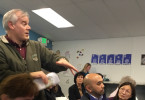A Los Altos resident has shared a Comment Letter to the VTA with Lalahpolitico. The Daily Post published a similar “Guest Opinion” by this Los Altos resident on January 6, 2015. If you want to weigh in with the VTA, the public comment period has been extended to January 14th. If you want to read proponents of the dedicated bus lanes on El Camino, you can find them in comments at MV Voice online.
[hr] COMMENT LETTER TO THE VTA ON THE ENVIRONMENTAL IMPACT REPORT FOR VTA EXPRESS BUS LANES ON EL CAMINO REAL
I read the draft EIR at http://www.vta.org/sfc/servlet.shepherd/document/download/069A0000001fFdAIAU
I also attended the evening meeting in Mountain View on November 20th. I appreciated the brevity of the presentations and the opportunity for so many members of the public to speak.
With respect, I offer these comments on the EIR:
(1) Much of the data is theoretical rather than empirical.
Prior to the meeting I spoke to a representative from the VTA and told him that if he wanted to see the impact of cutting car lanes, all he had to do was drive through Menlo Park, where El Camino narrows from 3 car lanes in each direction to 2. He asked if that was because of construction. He was completely unaware that Menlo Park narrowed El Camino several years ago in order to add median strips.
The resulting congestions means that drivers like me use Middlefield Road in Palo Alto or divert through Menlo Park neighborhood streets west of El Camino.
CONCLUSION: EVERY member of the VTA board and VTA staff should be REQUIRED to drive up and down El Camino – from San Jose through Redwood City – during morning rush hour, during evening rush hour, and during the time kids get out of school.
Only then will you all understand existing congestion problems.
(2) Much of the data is just not plausible.
The claim that elapsed drive time from San Jose to University Avenue in Palo Alto would increase by only 3 minutes if bus lanes replace car lanes is impossible to believe. It took me 12 minutes just to get from El Camino at Showers Drive to Castro Street for the meeting!
In December 2004, one of Palo Alto’s traffic officials thought it would be a good idea to reduce Middlefield Road in the midtown shopping district from 4 lanes to 2. He set up a 3-hour test with cones one evening, but traffic slowed so badly – with honking horns and irate drivers – that the test was cut short and the plan to narrow the road was abandoned.
Simple logic indicates that narrowing the path significantly increases travel time.
CONCLUSION: Theories that defy logic are probably wrong.
(3) Fewer lanes cannot handle more cars.
One member of the public said that Castro Street in Mountain View carries more traffic since it was narrowed from 4 lanes to 2. That’s clearly impossible.
I was in Mountain View about 2:00 pm on a November weekday. I exited Central Expressway at Castro, which was so backed up that I had to wait on the Central side through a light change to avoid stopping on the RR tracks. Traffic was stop-and-go the entire length of Castro. I turned off at Church Street to look for a parking place. Ten minutes later I finally found a spot 4 blocks south of Castro. Elapsed time from exiting Central Expressway to a parking place: 20 minutes.
So yes, there is more traffic on Castro Street now because of more high-end restaurants and other business development. But that traffic is more congested because in addition to removing a lane, parking places have been given over to restaurants for outdoor seating.
CONCLUSION: Fewer lanes and fewer parking spaces increase congestion and greenhouse gases, as drivers circle the neighborhoods.
(4) Replacing El Camino car lanes with bus lanes doesn’t solve a problem. It diverts the problem to someone else’s patch.
Dilbert nails this perfectly:
<Sorry, Lalahpolitico cannot republish this copyright cartoon content>
Traffic is like water: it looks for the path of least resistance. If you dam up the main artery, drivers will shunt through residential areas.
You have studied diversion problems at intersections, but not general traffic flow through neighborhoods where children play and ride their bikes and people feel safe crossing streets.
Frustrated drivers are not safe drivers. They tend to speed and neglect stop signs. In addition to driving dangerously, cars will spend more time on the roads, spewing fumes around homes, parks and schools – adding to the increased greenhouse gases from stalled traffic on El Camino and at F-rated intersections.
CONCLUSION: As one speaker noted, “Don’t make my neighborhood your collateral damage.”
(5) The last mile problem has not been addressed.
Several people spoke about wheelchair travelers getting ON a bus. What was not mentioned was the problem of those people getting TO and FROM the bus.
Not everyone lives and works along the El Camino corridor, so must drive or bike to a bus stop (assuming it’s too far to walk). The EIR says drivers can park on side streets. But most cities already have huge parking problems.
And once I get off the bus, how do I get to my final destination if my car is back where I boarded?
CONCLUSION: Without efficient connectors to jobs, schools, shopping, etc. off El Camino, the bus is impractical.
(6) Planned development along the El Camino corridor will significantly increase traffic.
Just two examples, just from Mountain View:
§ Mountain View City Council approved the second phase of the redevelopment of San Antonio Shopping Center. The project includes a 50,000-square-foot movie theater, 167-room hotel and a parking garage with over 1,300 spaces. It also plans for restaurants and shops … and office space likely to leased by LinkedIn, with space for about 2,000 employees. http://www.mv-voice.com/news/2014/12/03/council-oks-san-antonio-center-project-milk-pail-market-saved
§ Santana Row’s developer is set to buy most of Mountain View’s largest shopping center. The 33-acre purchase includes nearly all of the shopping center that’s still developed with single-story buildings: the sites of Trader Joe’s, Walmart, Kohl’s, 24-Hour Fitness, Fresh Choice and JoAnn fabrics. http://www.mv-voice.com/news/2014/12/17/santana-row-developer-makes-deal-to-buy-san-antonio-shopping-center
CONCLUSION: Recent development over the past 2 years has significantly increased travel time on El Camino. Additional projects, large and small, will cause gridlock up and down the corridor.
(7) Costs are high, benefits are dubious, disruption is guaranteed.
Mountain View “Council member Ronit Bryant noted that San Mateo County decided against a similar system and questioned whether it was worth the increase in ridership of 4,000 riders a day over the 522 line.” http://www.mv-voice.com/print/story/2014/12/19/el-camino-bus-lanes-win-praise-from-public-concern-from-council
The EIR states capital cost estimates up to $232.7M for Alternative 4c.
CONCLUSION: Spending millions on a project for a short stretch of El Camino – with serious consequences and arguable benefits – is not a good use of taxpayer dollars.
We need a comprehensive plan that incorporates BART, Caltrain, light rail, the possibility of High Speed Rail, as well as new technologies like self-driving cars and Elon Musk’s Hyperloop.
Thank you for the opportunity to comment.
[hr]AND WHAT AND WHO IS ABAG?
Here’s another bit of interesting info. ABAG (another bunch of officials we never elected) keeps telling us how we have to grow our cities, based on very dubious “data”:
… the regional job growth in the past four years has put the Bay Area on track to reach the 30-year total predicted by the Association of Bay Area Governments and the regional Metropolitan Transportation Commission within the next decade.
Officials from the two agencies said the earlier estimates were based on long-term job patterns in the Bay Area. The report really is more of a tool to help local agencies making decisions about investing in housing and transportation.
‘Correction’ needed
And while growth is going gangbusters today, the report is about the long-term picture.
“I’d be very surprised if (regional job growth) didn’t slow down,” said Cynthia Kroll, chief economist with the Association of Bay Area Governments.
Kroll may have a point, given the two job slumps in the past 15 years — first the 2001 dot-com bust, then the 2007-10 recession.
“Within the next seven years, we are certainly going to see some kind of correction,” said Tracey Grose, vice president of the job-promoting Bay Area Council Economic Institute. “How big it is, I can’t tell you.”
Lalahpolitico: If you want to read articles by proponents of more jobs, housing, and mass transportation in the San Jose and San Franciso area, see Spur.org.








